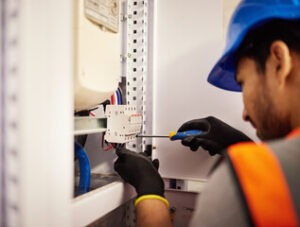The trades are a great career choice for people who like hands-on work and need a flexible schedule. Many of these jobs pay well, and the training is affordable compared to a four-year college track.

Nashville Electricians install, maintain, and repair electrical wiring and equipment. They follow sketches or blueprints to determine the location of wiring, and they ensure that their work meets codes.
An electrician is a skilled tradesperson who specializes in installing and maintaining electrical systems. Their responsibilities include executing electrical wiring plans, installing fixtures and equipment, troubleshooting problems, and repairing and replacing wiring. They also ensure that their work meets safety regulations. The duties of an electrician vary by state, but many require a license and certification.
Electricians can find jobs in construction, manufacturing, and a wide variety of other industries. They must be able to read and understand blueprints and schematics, as well as use hand tools and power tools. They may also need to climb on ladders or scaffolding in order to access hard-to-reach areas. It is also important for them to have perfect color vision, as all wiring has a specific color and special markings printed on the insulation that helps identify which wires connect to what.
Some electricians choose to work independently and manage their own business, while others opt to work within a larger electrical firm or company as a journeyman. Both options offer advantages, and it is up to each individual electrician to decide which one best suits them. In either case, it is important to start the job search early and begin working toward a career in this field.
A good way to get started is by attending a vocational school, such as Lincoln Tech, to obtain a Certificate of Completion in Electrical and Electronics Technology. This is an in-depth, hands-on program that teaches you everything about becoming a professional electrician. In addition, you can start a career through an apprenticeship. Apprenticeships can be union or non-union, and they typically involve spending a few years working alongside experienced electricians.
A typical electrician’s work day involves reading technical and wiring instructions, including blueprints and schematics, and installing electrical systems. They also need to troubleshoot problems and repair equipment, as well as ensuring that their work meets all applicable safety standards. In some cases, they may need to liaise with customers before a job begins and afterwards when invoicing and securing payment. Depending on their experience, some electricians might also be required to travel to different job sites.
Education and training requirements
Electricians work with a wide variety of electrical systems, including those in homes and businesses. They are responsible for installing wiring and lighting, repairing broken electrical components, and rewiring outdated or unsafe systems. They must also be able to troubleshoot problems and keep up with yearly changes in electrical codes. They must also have good communications skills to interact with customers and co-workers.
Most electricians start their careers with a high school diploma or equivalent and learn the trade through on-the-job training, typically through an apprenticeship program that lasts four to five years. These programs involve 144 hours of technical training per year and 2,000 hours of practical on-the-job experience. Many apprentices attend a vocational school to supplement their formal education. These schools offer courses in blueprint reading, safety and first aid practices, and electrical theory. Those who want to advance to journeyman electrician or master electrician status must complete additional courses and obtain a license. Each state sets its own requirements for licensure.
Regardless of the educational path, all electricians must have extensive on-the-job training to become qualified for their jobs. This is important because it ensures that the electrician has a broad understanding of different power systems and is familiar with the best practices for handling hazardous materials. In addition, an electrician must have excellent vision and hand-eye coordination to be able to read and interpret the many diagrams, blueprints, and technical documents they encounter on job sites.
The job outlook for electricians is strong and the demand for skilled workers is growing. The Bureau of Labor Statistics projects that the number of electricians will increase by 6% from 2022 to 2032. This is due to increased demand for new construction and renovations, as well as advances in alternative energy sources.
To increase their chances of getting a job, electricians should create professional resumes that highlight their skills and training. They should also prepare for interviews by researching the companies they are interviewing with and practicing common questions. Lastly, it is important for electricians to network with other industry professionals, as this can lead to job opportunities and valuable advice from experienced electricians.
Job outlook
In the United States, job opportunities for electricians are growing faster than average. They can be found in a variety of sectors, including residential construction, commercial building, and energy production. In addition, alternative power sources, such as wind and solar, are expected to become more popular in the coming years. This could lead to more demand for electricians to install and maintain these systems. However, employment growth in this sector may be dependent on government policy.
There are many benefits to becoming an electrician, but the profession does have its challenges. It requires a high level of physical stamina, and electricians should be strong enough to lift heavy components. They also need to be able to read technical diagrams and understand how to perform tests. In addition, the work can be dangerous, and electricians must take precautions to avoid electrical shocks.
Electricians must also have good communication skills, as they often work with customers. They need to be able to answer questions about the work they’re doing and explain the results of their tests. Finally, they must be able to work well under pressure. This is especially important in a fast-paced environment, such as new construction or remodeling projects.
The outlook for electricians depends on the economy, as the number of jobs fluctuates with the demand for building construction and maintenance. It is also affected by weather conditions, as electricians must be able to work outdoors in all kinds of weather.
Despite these challenges, the career offers excellent pay and plenty of opportunities for advancement. In addition to the traditional route of completing an apprenticeship, electricians can seek out certification programs offered by schools and employers. These programs can help them become better technicians and improve their job prospects.
The Bureau of Labor Statistics projects that the demand for electricians will increase by 9 percent over the next 10 years. This is much faster than the average for all occupations. In addition, construction spending is expected to rise, boosting demand for electricians. The outlook for electricians is even better in some states, such as Alaska and Delaware.
Work environment
Electricians work on the systems that supply power to homes, offices, factories, and other buildings. They install, repair, and maintain these systems to ensure that they are working properly. They also test and monitor electrical components for safety hazards. Additionally, they may need to install or remove trees, bushes, or brush that interfere with power lines and utilities.
The work environment for an electrician depends on their specialization and location. Some electricians may work in a residential setting, while others may choose to work on commercial or industrial projects. They also have the option to work as contractors or in-house employees, depending on their experience and expertise.
Some electricians have a flexible schedule and travel between job sites, while others may work full-time in one location. In either case, they must wear appropriate personal protective equipment, including rubber-insulated gloves and sleeves, hard hats, and safety shoes. They also need to use tools, which may include wrenches, drills, and screwdrivers.
A career as an electrician can be physically demanding and requires a high level of skill and precision. Therefore, it is important for electricians to maintain a balanced lifestyle, which allows them to relax and recharge between projects. This balance also helps them avoid fatigue and burnout, which can lead to dangerous errors or accidents.
The physical demands of this profession include long days of standing, stooping, and kneeling for extended periods. It also involves climbing ladders and working in tight or close spaces that contain live wires. These conditions can be uncomfortable and hazardous, especially in hot or humid weather. Electricians must also wear personal protective equipment when entering potentially dangerous areas, such as chemical plants or nuclear power stations.
Due to the highly specialized nature of their job, electricians must be constantly learning and updating their skills. They must also maintain a balance between their professional and personal lives, which can be difficult when they are working on urgent projects or on call for emergencies. Having a good work-life balance also allows electricians to maintain a healthy lifestyle and reduce stress and anxiety.






